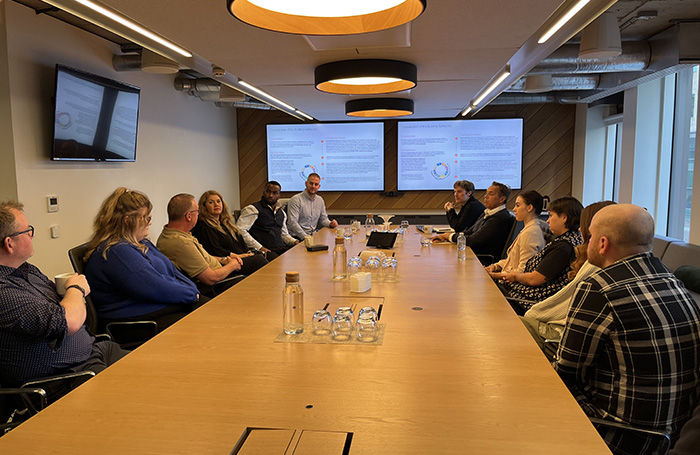Dyslexia, as a type of neurological difference, is often misunderstood. Most people associate it with difficulties in reading, writing, and spelling, and while those challenges are real, they’re only part of the picture.
With Dyslexia Awareness Week (from Monday 6 October 2025) on the horizon, it’s the perfect opportunity for architecture practices to review what they know about this neurodivergence and how colleagues with dyslexia in the workplace may benefit from extra support.
Around one in 10 people are dyslexic, and within the architecture industry this figure might even be 10% higher.
While dyslexia presents challenges in the workplace, it’s often now reframed as a strength, particularly in fields like architecture and design, where visual thinking and creative problem-solving are essential. However, while there has been a shift in perception, colleagues with dyslexia may still need support without knowing what help is available to them.
“Creating a supportive work culture is a key step in making sure dyslexic staff feel they can open up about the struggles they might be facing, and begin to have conversations about what adjustments they might need in order to perform to the best of their ability,” says Jane Craig, Founding Director of charity Dyslexia Sparks, which supports dyslexic individuals through assessments, training and advice.
“Often dyslexic adults have developed a range of their own strategies in order to cope, and they already know what would help them to be more successful at work - developing an understanding of dyslexia, opening up conversations, and creating a culture where staff feel they can ask for adjustments to be made - can all be crucial. Talking to dyslexic employees, asking them about what they see as their strengths, as well as areas which might bring them more challenge, is a great way to develop understanding. Further understanding can also be gained through workplace training, helping to deepen employees’ and managers’ knowledge.”
How does dyslexia effect one architect?
“Having dyslexia allows me to step outside of the conventional, linear ways of thinking,” Luke Sach, Associate Architect at DLa Architecture and President of the Leeds Society of Architects, says. “I have found I excel in being able to visualise projects more holistically, while finding I’m also better at communicating through drawings, models and in person rather than in a written medium.
He continues: “I have found big strengths of mine are problem solving, spatial design and being able to think outside of the box. My brain tends to weave multiple thoughts in parallel, rather like a quantum computer, and arrive at the right answer for a project in a more creative and efficient way when compared to a step-by-step approach.”
Like most people with dyslexia, Luke’s own experience is unique, which means his key strengths and development areas often differ from those around him. As Luke points out, an architect with dyslexia can be a valuable member of any team, bringing a distinct set of skills and perspectives, just like any neurotypical colleague.

What can employees do to help people with dyslexia on their employment journey?
Luke’s journey to becoming a practicing architect has been a tough one, he admits. At school a misguided careers advisor told him to give up on his dreams of becoming an architect. He also found there was very little support, often having to spend twice as long in preparation or needing extra time just to demonstrate his ability during time-pressured written tasks.
Although there were suspicions he was dyslexic during his time at school, it wasn’t until university that Luke received an assessment, confirming his neurodivergence. The formal diagnosis, and the relief that came with it, gave Luke a new energy to channel his time and effort into the skills and pathways that he knew could open up opportunities. The diagnosis also unlocked more support for him thrive.
Then came employment. The onboarding process for Part 1 and Part 2 entrants to practice can be major hurdle, Luke says. A large part of students and assistants’ workloads tend to be text-heavy - for instance research tasks and technical reports to read - and this can be overwhelming for people with dyslexia. Design decisions and design development then become a larger part of the role once trainees are more experienced.
The turning point for Luke, he recalls, was when his practice director realised relatively early on that he had a strength for 3D spatial design, and that his talents could be put to much more productive use to benefit the team.
Companies aren’t always set up for people who think differently, Luke suggests. Even in large practices with an HR department, unless they have experience of supporting dyslexic employees or one of the leaders has dyslexia, it’s not something that tends to get picked up and managed supportively.
Luke says he would like to get the message out that dyslexia should be seen instead as a strength - or ‘superpower’ - and any negative preconceptions are highly outweighed by the many positives and benefits that can be harnessed, making a dyslexic employee a valuable member of any team.

How can employers avoid creating barriers for dyslexic architects?
Jane agrees that the first step in supporting dyslexia within the workplace is recognising the value it can bring, and then allowing employees to work in ways that enable them to showcase their unique strengths.
“Dyslexia often brings a number of advantages,” she says. “Many dyslexic individuals will need more time for reading, may find it hard to organise their thoughts in writing, and may struggle with deadlines, but they are great problem-solvers, which is most likely the reason for the higher number of dyslexic individuals within architecture. Often verbal communication and people skills are really strong too.”
Here, Jane offers suggested ways in which architectural practices can make changes that could support colleagues with dyslexia:
Think about written communications
“Many dyslexic individuals need more time for reading, so make sure long documents are sent in advance of meetings, and information is sent in advance of training sessions. This allows the individual to take the time they need to read, re-read, and process the information, which in turn means they can contribute their ideas fully. Large amounts of text could be presented in a visually friendly way, such as using tables to break up information or bullet points to highlight important aspects and help the recipient to focus attention.”
This can apply to general communications across your business including how information is shared on your practice website, in client correspondence, or project briefs.
Assistive technologies can really help
“It’s likely that a dyslexic employee will already be aware that there are now assistive technologies that can dramatically improve their written communications. It’s important that employees are given time and support to use these tools and a chance to try them out at work to see what helps. Microsoft Word comes with tools such as Read Aloud, which allows dyslexic individuals to process information without the time and energy needed for reading and re-reading. Co-Pilot, Microsoft’s AI assistant, can help organise work schedules and improve written output. Free app Grammarly edits and corrects grammar, spelling and punctuation. Chat GPT Rewrite will take raw text and polish it into something well-written.”
It is recommended that those who use large language models such as ChatGPT and Co-Pilot check with their practice’s privacy and AI policies before use
Is your recruitment process creating barriers?
“There are easy ways to make your recruitment processes more inclusive for those with neurological differences, including dyslexia. Sending reading material or interview questions in advance and allowing the individual to have notes present will support any difficulties they may have with memory and help to ensure they are performing their best. Asking interview questions in a chronological order, and not including more than one question at a time, will help them to organise their thoughts and respond under time pressure.”
Keeping the noise down
“Many dyslexic individuals will find it more difficult to concentrate in busy or noisy work environments. Shared or open-plan offices, for example, will often create distractions that may make it harder for dyslexic individuals to focus on their work. Consider how you might create quieter work spaces, or support the use of noise-cancelling headphones to overcome some of these possible challenges. It’s also important to be considerate of an individual’s need for uninterrupted time, and the use of visual indicators that someone cannot be disturbed, for example, might be helpful.”
Whether you're an employee with dyslexia or a supportive employer, Dyslexia Sparks is running a free webinar in November (2025) to help provide clear, actionable steps to ensure you or your employee has an inclusive, supportive work environment. Sign up to the webinar.
Thanks to Jane Craig, Dyslexia Sparks, and Luke Sach, DLa Architects.
Text by Neal Morris. This is a Professional Feature edited by the RIBA Practice team. Send us your feedback and ideas.
RIBA Core Curriculum topic: Inclusive environments.
As part of the flexible RIBA CPD programme, professional features count as microlearning. See further information on the updated RIBA CPD core curriculum and on fulfilling your CPD requirements as a RIBA Chartered Member.









